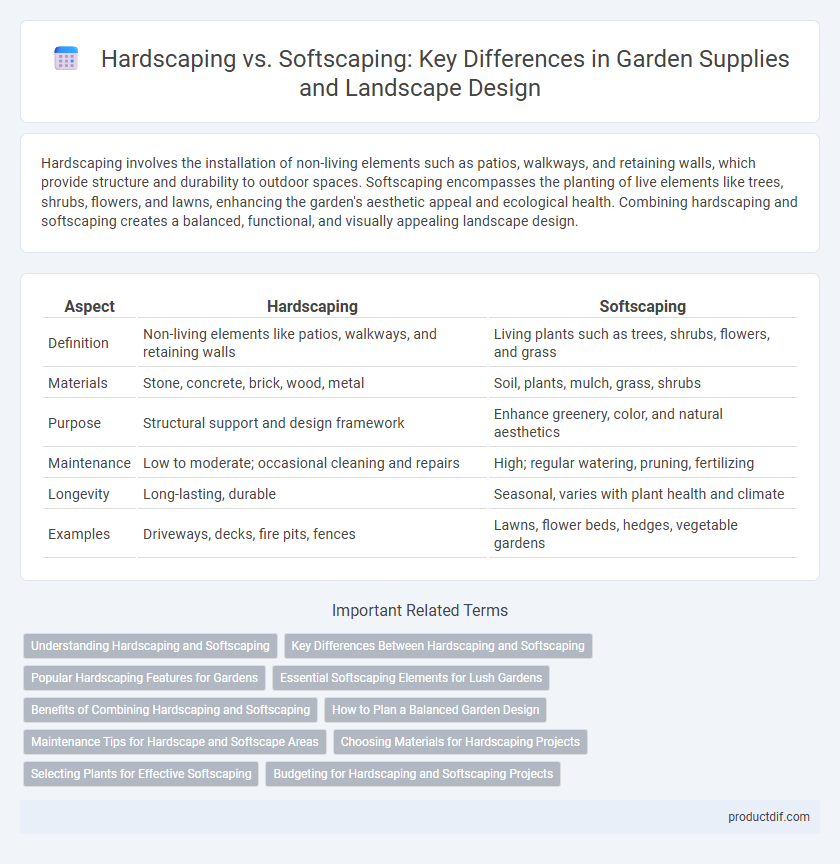Hardscaping involves the installation of non-living elements such as patios, walkways, and retaining walls, which provide structure and durability to outdoor spaces. Softscaping encompasses the planting of live elements like trees, shrubs, flowers, and lawns, enhancing the garden's aesthetic appeal and ecological health. Combining hardscaping and softscaping creates a balanced, functional, and visually appealing landscape design.
Table of Comparison
| Aspect | Hardscaping | Softscaping |
|---|---|---|
| Definition | Non-living elements like patios, walkways, and retaining walls | Living plants such as trees, shrubs, flowers, and grass |
| Materials | Stone, concrete, brick, wood, metal | Soil, plants, mulch, grass, shrubs |
| Purpose | Structural support and design framework | Enhance greenery, color, and natural aesthetics |
| Maintenance | Low to moderate; occasional cleaning and repairs | High; regular watering, pruning, fertilizing |
| Longevity | Long-lasting, durable | Seasonal, varies with plant health and climate |
| Examples | Driveways, decks, fire pits, fences | Lawns, flower beds, hedges, vegetable gardens |
Understanding Hardscaping and Softscaping
Hardscaping involves the installation of non-living elements such as patios, walkways, retaining walls, and outdoor kitchens, providing structure and durability to garden landscapes. Softscaping incorporates living components like plants, trees, lawns, and flowers, enhancing aesthetic appeal and ecological balance. Effective garden design integrates both hardscaping and softscaping to create functional, attractive outdoor spaces.
Key Differences Between Hardscaping and Softscaping
Hardscaping involves the installation of permanent, non-living elements like patios, pathways, retaining walls, and decks, providing structure and durability to outdoor spaces. Softscaping refers to the living components such as plants, trees, shrubs, and lawns that enhance aesthetics and contribute to a garden's ecosystem. Key differences lie in material composition, maintenance needs, and impact on landscape functionality, with hardscaping offering stability and design framework while softscaping supports biodiversity and seasonal variation.
Popular Hardscaping Features for Gardens
Popular hardscaping features for gardens include patios, walkways, retaining walls, and outdoor kitchens, which add structure and functionality to outdoor spaces. Materials such as natural stone, brick, concrete, and pavers are commonly used to create durable and visually appealing designs. Incorporating hardscaping elements enhances garden aesthetics, increases property value, and provides versatile areas for entertaining and relaxation.
Essential Softscaping Elements for Lush Gardens
Essential softscaping elements that contribute to lush gardens include a variety of plants, trees, shrubs, and ground covers, which enhance texture and color diversity. Incorporating flowering plants and ornamental grasses not only boosts aesthetic appeal but also supports pollinators and local ecosystems. Proper soil preparation and organic mulch application improve plant health and moisture retention, essential for vibrant, thriving garden landscapes.
Benefits of Combining Hardscaping and Softscaping
Combining hardscaping and softscaping enhances garden functionality and aesthetic appeal by creating a balanced outdoor environment that supports both structure and greenery. Hardscaping elements like patios and retaining walls provide durability and low maintenance, while softscaping with plants and flowers adds life, color, and ecological benefits such as improved air quality and biodiversity. This integration increases property value, extends usable outdoor space, and promotes a sustainable landscape design that adapts well to seasonal changes.
How to Plan a Balanced Garden Design
Planning a balanced garden design involves integrating hardscaping elements such as patios, walkways, and retaining walls with softscaping features like plants, trees, and shrubs to create both structure and natural beauty. Consider the spatial layout by allocating appropriate zones for durable materials alongside lush greenery to enhance functionality and aesthetic appeal. Prioritize drainage solutions and soil quality to ensure harmony between hard surfaces and living plants, promoting a sustainable and visually appealing garden space.
Maintenance Tips for Hardscape and Softscape Areas
Effective maintenance of hardscape areas involves regular cleaning to prevent dirt buildup, sealing surfaces to protect against weather damage, and inspecting for cracks or structural issues. Softscape areas require routine watering, pruning, fertilizing, and pest control to ensure healthy plant growth and vibrant landscapes. Combining these maintenance practices enhances the longevity and aesthetic appeal of both hardscape features like patios and walkways, and softscape elements such as lawns and flower beds.
Choosing Materials for Hardscaping Projects
Selecting materials for hardscaping projects involves considering durability, aesthetics, and compatibility with the landscape design. Options such as natural stone, concrete pavers, and brick offer varying textures and colors that enhance outdoor spaces while providing long-lasting structural support. Proper material choice ensures functionality, weather resistance, and complements surrounding vegetation in both residential and commercial garden environments.
Selecting Plants for Effective Softscaping
Selecting plants for effective softscaping involves choosing species that thrive in the local climate, soil type, and sunlight conditions to ensure longevity and minimal maintenance. Incorporating a diverse mix of perennials, shrubs, and ground covers enhances texture and visual interest while promoting biodiversity. Proper spacing and layering techniques create natural aesthetics and improve plant health, contributing to a sustainable and balanced garden design.
Budgeting for Hardscaping and Softscaping Projects
Budgeting for hardscaping projects requires allocating funds for materials like stone, concrete, and pavers, which often come with higher initial costs but offer long-term durability and low maintenance. Softscaping expenses typically include plants, soil, mulch, and irrigation systems, with ongoing costs for seasonal care and replacement. Balancing the budget between hardscape features such as patios or retaining walls and softscape elements like trees and shrubs ensures an aesthetically pleasing and sustainable garden design.
Hardscaping vs Softscaping Infographic

 productdif.com
productdif.com